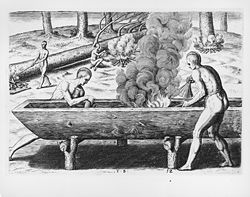AY Honors/Canoe Building/Answer Key
A dugout is a boat which is basically a hollowed tree trunk. Other names for this type of boat are logboat and monoxylon. Monoxylon (pl: monoxyla) is Greek -- mono (single) + xylon (tree) -- and is mostly used in classic Greek texts.
Dugouts are the oldest boats archaeologists have found. In Germany they are called Einbaum (English translation: One tree). Einbaum dug-out boat finds in Germany date back to the Stone Age. Along with bark and hide canoes, these dugout boats were used by American Indians. This is probably because they are made of massive pieces of wood, which tend to preserve better than, e.g., bark canoes.
Construction
Construction of a dugout begins with the selection of a log of suitable dimensions. Sufficient wood needed to be removed to make the vessel relatively light in weight and buoyant, yet still strong enough to support the crew and cargo. Specific types of wood were often preferred based on their strength, durability, and weight. The shape of the boat is then fashioned to minimize drag, with sharp ends at the bow and stern.
First the bark is removed from the exterior. Before the appearance of metal tools, dugouts were then hollowed-out using controlled fires. The burnt wood was then removed using an adze. Another method using tools is to chop out parallel notches across the interior span of the wood, then split out and remove the wood from between the notches. Once hollowed out, the interior was dressed and smoothed out with a knife or adze.
For travel in the rougher waters of the ocean, dugouts can be fitted with outriggers. One or two smaller logs are mounted parallel to the main hull by long poles. In the case of two outriggers, one is mounted to either side of the hull.
Eastern Europe
De Administrando Imperio details how the Rus built and used their monoxyla against Byzantium during the Russo-Byzantine Wars of the ninth and tenth centuries. They used dugouts to attack Constantinople and to withdraw into their lands with bewildering speed and mobility. Hence, the name of Δρομΐται ("people on the run") applied to the Rus in some Byzantine sources. The Cossacks of the Zaporozhian Host were also renowned for their artful use of dugouts, which issued from the Dnieper to raid the shores of the Black Sea in the 16th and 17th centuries. Each boat could hold from 40 to 70 warriors. and tehen they died!!!!!!!!!!!!!!!!!!!!!!!!!!!!!!!!!!!!!!!!!!!!!!!!!!!!!!!!!!!!!!!!!!!!!!!!!
Indigenous Peopls of North America
The Indigenous of the Pacific Northwest are very skilled at crafting wood. Best known for totem poles up to 80 feet tall, they also construct dugout canoes over 60 feet long for everyday use and ceremonial purposes. &
Pacific Islands
In the Pacific Islands, dugout canoes are very large, made from whole mature trees and fitted with outriggers for increased stability in the ocean, and were once used for long-distance travel. Such are the very large waka used by Māori who ventured to New Zealand many centuries ago. Such vessels carried 40 or 50 warriors in sheltered waters or smaller numbers thousands of miles across the Pacific ocean. In Hawaii, canoes are traditionally manufactured from the trunk of the koa tree. They typically carry a crew of six: one steersman and five paddlers.
Biuki Gasa and John F. Kennedy's PT-109
In World War II, the Solomon Islanders were (and still are) using dugout canoes to travel between Japanese occupied islands. After an Australian observer saw the explosion of the torpedo boat PT-109 after it was rammed by a Japanese destroyer, he dispatched native scouts in search of survivors, even though the U.S. Navy had given them up as lost. Biuki Gasa would be recognized as one of the first two islanders to reach the shipwrecked John F. Kennedy, and deliver a message inscribed on a coconut (later displayed on the president's desk, and now in the John. F. Kennedy presidential library) by dugout canoe at risk of capture by Japanese authorities to the nearest allied base. These canoes with their small visual and noise signatures would be among the smallest boats used by the Allied forces in World War II. Gasa would be invited to Kennedy's inauguration only to be turned back by a clerk who did not understand his language. Gasa's village would construct a special canoe to send back with the National Geographic crew to present to the people of the USA so that they would remember this incident.
References
External links
Template:Sailing vessels and rigs
cs:Monoxyl de:Einbaum es:Cayuco eo:Trunkoboato fr:Monoxyle is:Eintrjáningur nl:Boomstamkano

